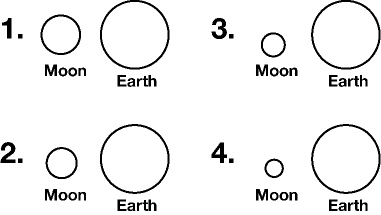Modified True/False
Indicate
whether the statement is true or false. If false, change the identified word or phrase to make
the statement true.
|
|
|
1.
|
The planet with the largest diameter and mass, the largest strength of gravity
and the most moons is Uranus. _________________________
|
|
|
2.
|
The planet with the widest range of surface temperatures is Earth.
_________________________
|
Multiple Choice
Identify the
choice that best completes the statement or answers the question.
|
|
|
3.
|
The factor most responsible for the seasons of the year is the:
a. | distance of Earth from the Sun. | b. | speed of Earth in its
orbit. | c. | tilt of Earth on its axis. | d. | sunspot cycle. |
|
|
|
4.
|
Which planet is closest to Earth in diameter, mass and strength of
gravity?
a. | Mercury | b. | Venus | c. | Mars
| d. | Jupiter |
|
|
|
5.
|
Which of these planets has the most extreme variations in temperature?
a. | Mercury | b. | Venus | c. | Jupiter | d. | Pluto |
|
|
|
6.
|
Mars is similar to Earth in all of these ways EXCEPT:
a. | it has polar ice caps. | b. | it is tilted so it has
seasons. | c. | its mass is about the same as Earth’s. | d. | its day is about the
same length as Earth’s. |
|
|
|
7.
|
All of the following planets rotate backwards (east to west) EXCEPT:
a. | Uranus. | b. | Pluto. | c. | Mercury. | d. | Venus. |
|
|
|
8.
|
The graph which best illustrates the average temperatures of the planets in the
solar system is:
|
|
|
9.
|
It would be difficult to live on the moon because it lacks all of the following
EXCEPT:
a. | air. | b. | water. | c. | gravity. | d. | normal
temperatures. |
|
|
|
10.
|
The diagram which best represents the comparison between the diameters of the
moon and Earth is: 
|
|
|
11.
|
Craters caused by impact with meteorites are more common on the surface of the
planet Mars than on Earth, Venus or Jupiter because:
a. | Mars has the greatest surface area and receives more impacts. | b. | the tiny moons of
Mars are breaking into pieces and showering it with rock fragments. | c. | the thin atmosphere
of Mars offers little protection from falling rock fragments. | d. | Mars has a strong
magnetic field that attracts iron-bearing rocks from outer space. |
|
|
|
12.
|
Gas planets formed because they were:
a. | hotter and more massive. | b. | hotter and less massive. | c. | cooler and more
massive. | d. | cooler and less massive. |
|
Completion
Complete each
statement.
|
|
|
Select the correct term to complete each sentence. There are extra terms in
the list.| Jupiter | Venus | Mars | | Neptune | inertia | comet | | asteroid | meteorite | gas | | terrestrial | planets | masses | | | |
|
|
|
13.
|
The planet that is most nearly the same as Earth in diameter, mass and strength
of gravity is ____________________.
|
Short Answer
|
|
|
14.
|
What makes up Saturn’s rings?
|
|
|
15.
|
State two reasons why Earth’s moon would a difficult place for humans to
live.
|
|
|
16.
|
Explain why Earth’s northern hemisphere experiences warmer temperatures in
summer and cooler temperatures in winter.
|
|
|
17.
|
What evidence suggests that Mars may have had flowing water on its surface at
one time?
|
Essay
|
|
|
18.
|
Some astronomers have suggested that Pluto should not be classified as a planet.
Describe two other categories of solar system objects into which Pluto might fit.
|